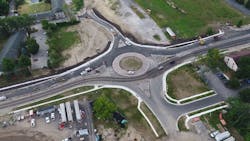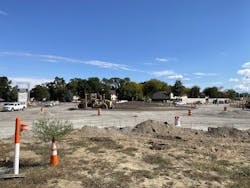The Shape of Rural and Local Road Safety
The Ohio DOT (ODOT) is officially responsible for state, interstate, and U.S. routes throughout the Buckeye State.
But the agency has long stood ready to aid in the development of community roadways serving local and rural populations. At present, ODOT is very excited about the use of modern roundabouts at intersections as well as a coming experiment in smart mobility research. ODOT believes these efforts can help change and improve lives.
Part I: Round and Round
It might seem strange, but roundabouts at roadway intersections have something of a fan club. ODOT’s Local Transportation Assistance Program (LTAP) sponsors an annual roundabouts conference to discuss and exchange new ideas about these intersections and their use. Victoria Beale, the head of Ohio LTAP, is a self-described roundabout fan:
“Those of us who love them really love them,” she declared. “We have held past conferences in communities near actual roundabouts so we could physically study them during lunches. We always get excited when we can see a new roundabout.”
The modern roundabout is a circular roadway intersection or junction which permits traffic to flow in a counterclockwise direction around a central island. Roundabout designs include divides—or “splitter islands”—in the middle of the roadways approaching the intersection. These details cause vehicles to slow down and enter the intersection with greater care, making overall collisions far less likely. Roundabouts also alter the angle of entering vehicles, changing them from 90 degrees to 20 degrees or so. The combination of lower speeds and angle changes can make all the difference in the severity of potential collisions.
“Cars entering an ordinary traffic intersection at high speeds and hitting other vehicles in ‘T-Bone’ crashes are the worst causes of fatalities and injuries,” said Christopher Waterfield, a district traffic engineer with ODOT District 2. “A collision with another car at a reduced speed and a glancing angle may cause property damage, but it’s a crash everyone can walk away from.”
Studies by the IIHS and Federal Highway Administration have shown roundabouts reduce overall collisions by 37%, injury collisions by 75%, and fatalities by 90%.
This fall, ODOT opened six roundabouts to through traffic in Henry and Lucas counties. The department’s District 2 Public Information Office declared this series of openings “Roundabout-palooza” to build public awareness. The U.S. Route 20A corridor in Lucas County saw three new roundabouts open in a 3-mile span, built for $3 million. A planned $45 million I-475 widening project opened two roundabouts in late October and will include an additional two roundabouts upon completion. Roundabouts are becoming better known in denser, urban or suburban communities. But this type of intersection can offer even more valuable safety opportunities to less populated areas because of the higher straightway speeds on rural roadways. These unfamiliar intersections are commonly met with resistance in less populated communities.
“Drivers unfamiliar with roundabouts have their doubts that they will actually work for them,” said Rebecca Dangelo, public information officer with District 2. “Our job is to listen and help educate people on how to drive them and why they are safer.”
There seems little doubt that ODOT will be both building and promoting the implementation of more roundabouts in the state. It is believed they will continue to gain public support as they become more common. Beale certainly believes many more will join her as fans of these intersections in the future. “We love roundabouts for one reason—they save lives,” she said.
Part II: The Future is One Step Closer
Much of the public at large remains skeptical about the future of automated (or self-driving) vehicles. But businesses and governments around the world are convinced this will be the next transportation revolution. Ohio has chosen to take a leadership role in this coming change.
ODOT’s DriveOhio is an initiative founded two years ago to further the goals of smart mobility. Answering a 2018 federal DOT notice of funding opportunity for Automated Driving Systems (ADS) Demonstration Grants, DriveOhio—along with the University of Cincinnati, Ohio State University, Ohio University (OU), and the Transportation Research Center—made a proposal for funding. In a highly competitive field of 73 applicants from across the nation, the proposal became one of eight projects to receive funding.
ODOT’s winning proposal will be to gather information through real-world experience. Appropriately named Deploying Automated Technology Anywhere (D.A.T.A.), the DriveOhio initiative will focus on operating self-driving vehicles along rural roads while recording information on how well—or not so well—they perform in remote areas.
“Self-driving cars will have to be designed and built according to federal policies for their safe and efficient use,” said Cynthia Jones, DriveOhio project manager. “But what will that mean? This is so new, the government does not yet know what it will need to guide infrastructure construction. Having actual vehicles recording experiences and what causes both successes and failures will help future policymakers with their decisions.”
D.A.T.A will focus on gathering three main types of information: Continuous streaming—data collected as vehicles smoothly operate along the roadway; Event data—information on the kinds of incidents that can prevent progress, like collisions; and mapping—creating realistic visual representations of the roadways for analysis. A driver will be on board the vehicle at all times in case of emergencies and to trigger data gathering along the route.
“A selling point of our proposal is that southeast Ohio is an ideal location for learning about how these vehicles can operate in places served less by major highways,” said Rich Granger, DriveOhio managing director of workforce and economic development. “These rural areas can be found in all other states in the continental U.S.A., and they are subject to a whole host of weather conditions and connectivity challenges. Whatever testing in Ohio reveals can be applied in other parts of the country as well.”
Jay Wilhelm, a Ph.D. assistant professor of mechanical engineering with OU, is a specialist in the study and design of automated systems and one of three university faculty working with ODOT on the D.A.T.A project. He is excited about the attention being paid to these remote areas and their inhabitants.
“Rural routes make up 68% of the roadways serving 19% of the population in the U.S.A.,” he said. “In Athens, we can see what it can be like for rural citizens struggling to get to needed services like food and health care safely. Self-driving cars promise a future where they can travel safely, and could truly improve their quality of life.”
Howard Wood, the recently named executive director of DriveOhio, knows he and his team have work to do: “It will take time to find and equip the right vehicles,” said Wood. “We will also be considering what other research partners we may need and how we want to collect, analyze, and share the data. We expect this will have a real impact on safety in ways that benefit as many people as possible, wherever they live.

